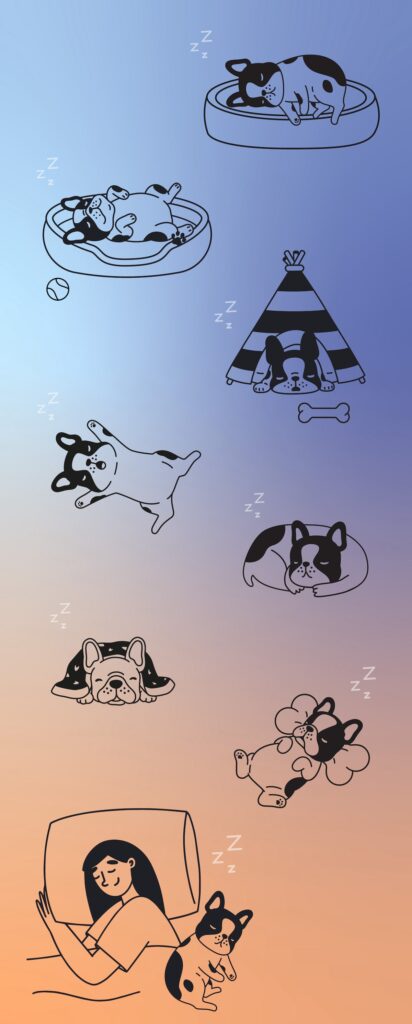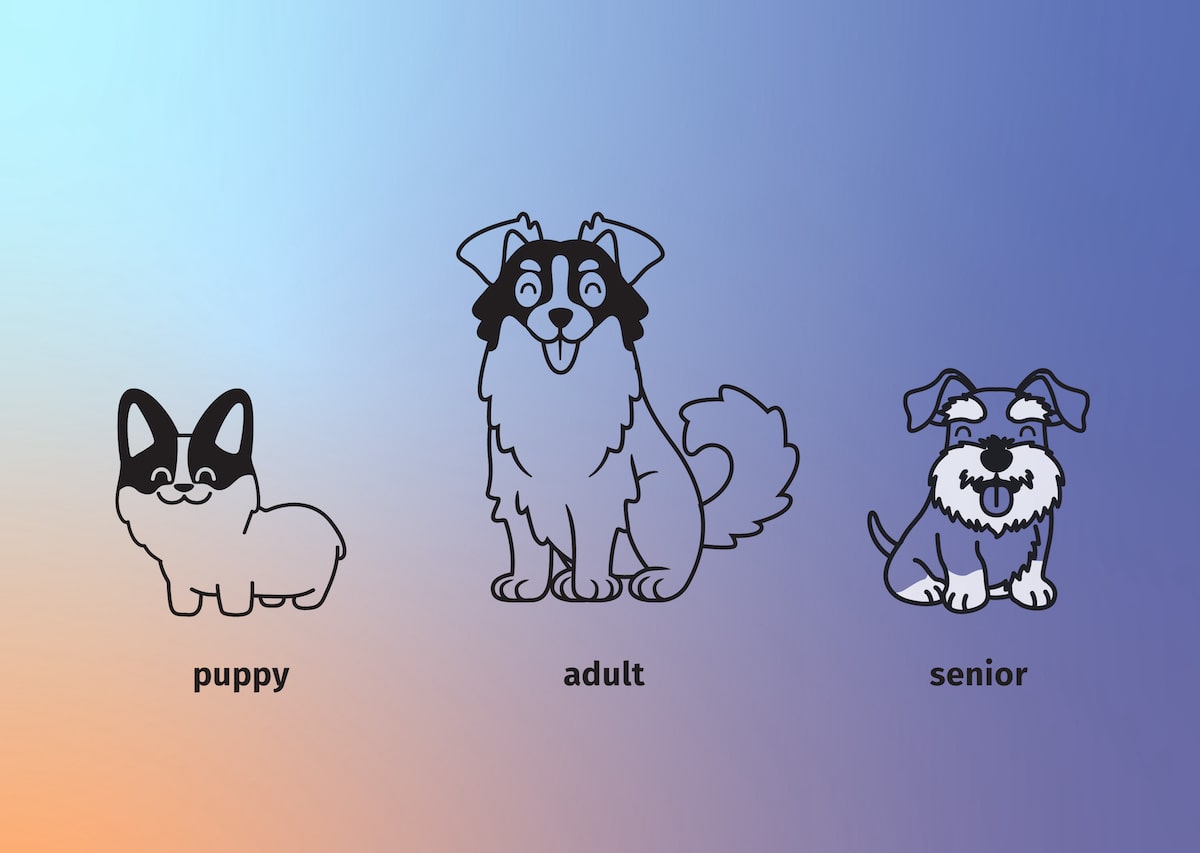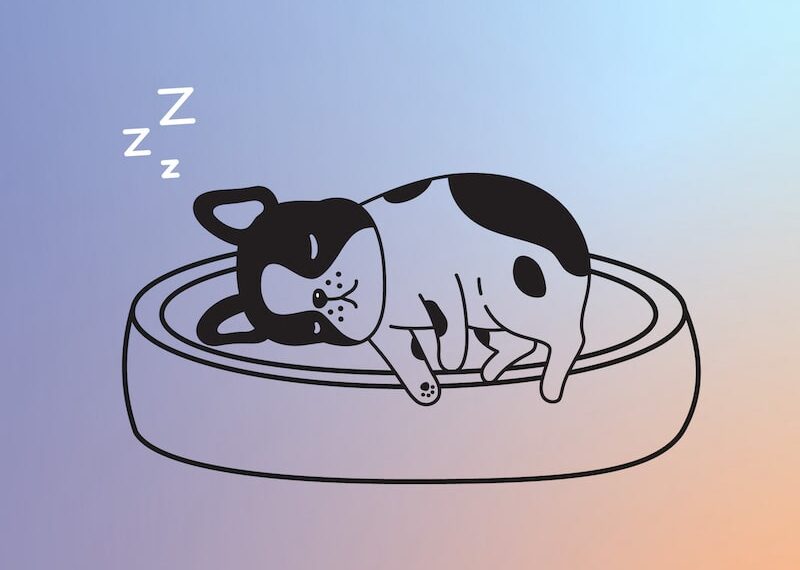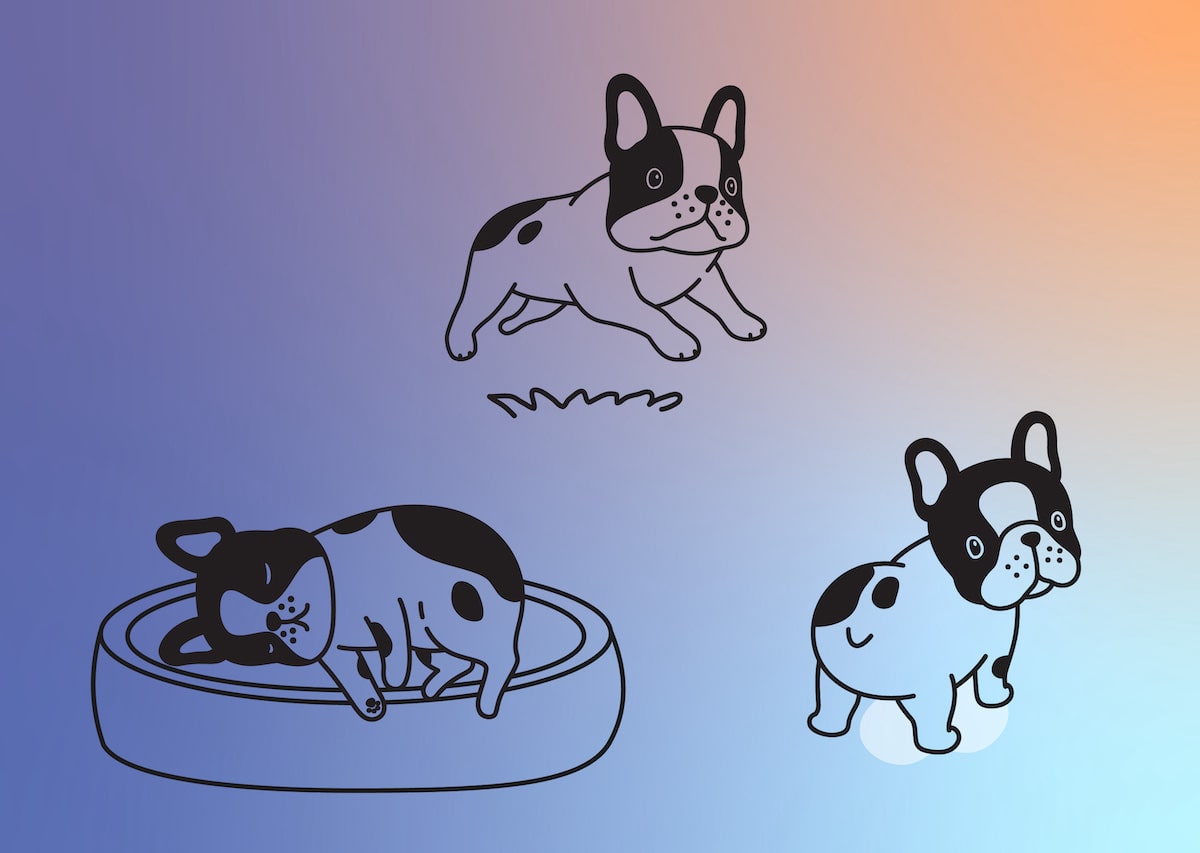Ever wondered what your dog is thinking about while they sleep? Alex Schechter, Doctor of Veterinary Medicine at Burwood Veterinary Hospital, says that a dog’s sleeping position “can be a window into their personality and what they want their owners to know about them.”
To help you get to know your furry friend better, this article breaks down eight common dog sleeping positions and explains what they mean. It also offers some tips on helping your dog get better sleep and information on dog health and sleep.
8 Dog Sleeping Positions and Their Meanings
Like humans, dogs sleep in positions that make them feel comfortable and safe. Read on below to learn more about what your dog’s favorite sleeping position says.
Side sleeper
Like human side sleepers, these pets might prefer a dog bed made with memory foam to provide pressure relief around their joints. This is especially true for older dogs. A cushioning bed like the BEDGEAR performance pet bed might be a good option.
Side sleeping is one of the most common pet sleeping positions for puppies and senior dogs. It indicates your pet is comfortable and secure, and likely getting REM sleep.
Belly up or on their back
If your dog is sleeping on its back with its belly up, it can mean a few different things.
Veterinarian Paola Cuevas says if your dog does this it is “definitely feeling comfortable and secure in its environment. For a dog, a belly-up position is a vulnerable position to assume, however, who doesn’t love to sleep while getting a belly rub?” Dr. Schechter says this body language indicates your dog is “ready for a snuggle” and “happy and content with life.”
According to Dr. Paula Simons, a vet at K9 of Mine, this position means your dog “feels very safe.” So if your dog is a cuddler, this might be one of their favorite sleeping positions!
Lion
The lion’s pose, also called the sphinx pose, features your dog lying on its tummy with its front paws stretched out. Dogs in this position will rest their heads on top of their paws and curl their back legs underneath them. Dogs will also sit like this with their head and neck raised off their paws to observe their surroundings.
Dogs in the lion’s pose are resting in a comfortable position, but not getting deep sleep. According to Dr. Schecter, if your dog is in this position and raises its hips up or rolls over onto its side, it is feeling “playful or excited.”
Superman
The superman position occurs when your dog flops down on its belly with its back and front legs stretched out away from its body. Dr. Cuevas says it is common to see this position when dogs are stretching out “over colder floors on hot summer days.” The superman position “allows them to keep cool, transferring their body heat to the cool floor.”
If you take your dog out to play on a hot summer day, it may get its best sleep supermaning on a cold surface afterwards.

Curled Up
The curled up position is one of the most common sleeping positions to find a dog in. Your dog will curl up into a donut position. It’s common to see a dog rest like this in its own bed.
Dr. Cuevas says, “smaller dogs or dogs living in cold climates tend to curl up to preserve their body temperature.” Dr. Simons says curling up may be a sign your dog is cold, but it might also just be a “natural behavior for them.”
Dogs laying in this position are also protecting their vital organs. So if your dog is new to your home or feeling anxious, it might curl up before it goes to bed.
Cuddled
In this position, your dog will cuddle up back to back with another person or animal. Some dogs cuddle to stay warm, while others are just showing love and affection. But, should your pup sleep in bed with you?
It turns out that letting your dog into bed with you might lower your sleep quality. We’d recommend cuddling up on the couch with your dog during its daytime naps, but settling your pet in its own bed at night.
Burrowed
The burrowed sleeping position involves your dog burrowing under blankets. According to Dr. Cuevas, a burrowing dog may also be searching for “warmth and comfort.” If you notice your dog likes to burrow, give them some blankets for their bed or consider swaddling them in a special swaddling shirt. This could help reduce your pet’s anxiety.
Head elevated
Finally, if your head sleeps with its head elevated on a pillow or another surface, you may want to take a trip to the vet. If your pet always sleeps this way, it may be having trouble breathing. If you also notice that your dog is breathing faster or more loudly, or is having trouble exercising, it may be a sign of heart disease.
On the other hand, if your dog is resting its head on a pillow without its eyes closed (and does not always sleep this way) it might just be a sign your dog is ready to hop up and play at a moment’s notice.
RELATED: Sleeping, Eating and Playing: How to Keep Your Pet Healthy
How Long Do Dogs Sleep?
Your dog’s sleeping habits will depend on its breed and health. For instance, senior dogs have very different sleep needs than adult dogs. Read on below to learn more about different dog sleeping patterns.
Breed and Size
Breed and size will have a big impact on how much your dog needs to snooze. For starters, large dogs need more sleep than smaller dogs. According to Dr. Phillips’ interview with mattress brand Casper, larger dogs do best with 18 hours of sleep per day, while smaller dogs only need 14 to 16 hours of sleep per day. Surprisingly, medium sized dogs only need 10 to 14 hours of sleep per day.
Your dog’s breed also plays a role in how much sleep it will need. Working and sporting breeds might sleep less than other dogs because they were bred to be active. Companion dogs tend to sleep more. Check out the American Kennel Club site to learn more about your pooch’s breed.

How Much Sleep Dogs Need Based on Age
Dogs also need more or less sleep depending on their age. Puppies need about 18-20 hours of sleep per day. Though, as any pet parent knows, you’ll want to make sure they have plenty of bathroom breaks in between naps to avoid accidents in the house.
Senior dogs also need a lot of sleep. Like puppies, they can sleep up to 18-20 hours per day. In contrast, adult dogs only need about 12-14 hours of sleep per night.
Health Issues That Impact Dogs’ Sleep
Finally, if your dog has health issues that impact its sleep, it may sleep more or less than a typical dog of its age and breed. Take a look at the list below to learn more.
- Sleep apnea – Luckily, sleep apnea is rare in dogs. But overweight or flat-faced breeds (like bulldogs) may struggle with sleep apnea. It will wake them up at night and leave them feeling tired throughout the day. If your dog snores loudly and wakes up often at night, you should visit your vet.
- Obesity – In addition to increasing instances of sleep apnea, obesity can make your dog feel tired and sluggish during the day. You should consider visiting your vet to learn safe ways to help your dog lose weight.
- Diabetes – Diabetes can also cause excessive sleepiness in dogs. If your dog is lethargic and spends more time sleeping than usual, it could be a sign something is wrong. Check out this article on canine diabetes to learn other warning signs.
- Depression/boredom – If your dog is depressed or bored it may sleep more. If your normally energetic dog is listless and sleeping more after a major life change, it could be depressed. Spend more time stimulating your dog with active play to try and combat depression or boredom.
- Cancer – Cancer and cancer treatments can make your dog more tired than normal. It is likely a dog dealing with cancer treatment will sleep more. Your dog may also feel restless and unable to sleep if it is in pain. If you notice your dog is unable to sleep comfortably, a visit to the vet might be worthwhile.

Dog Sleeping Behaviors
Outside of sleeping positions, there are several other dog sleeping behaviors that owners may notice. If you’ve ever seen your pet twitching or barking during sleep, you may have wondered what it meant. Read on below to find out!
Twitching in sleep
If your dog is twitching in sleep, it is probably dreaming! According to Dr. Cuevas, twitching in sleep happens when you (or your dog) is dreaming in REM sleep. In this phase of sleep, your dog’s eyes may be moving under closed eyelids, and you may see them twitch or shift around. This is nothing to worry about according to Dr. Jamie Whittenburg, veterinarian at Senior Tail Waggers, who says that “dogs twitching, barking, or moving their legs during sleep is normal in most cases and is likely the result of dreaming.”
Barking
Like twitching in sleep, barking or whining in sleep is a sign of dreaming when your dog is in REM sleep. If your dog is barking or whining in sleep, you may be concerned it is having a nightmare. However, you should not wake your dog up if that’s the case. According to Dr. Cuevas, “while it might be tempting to interrupt a dog’s nightmare and let them know they are safe, the recommendation is to wait until they wake up by themselves. Once the dog is awake we can cuddle and reassure them.” This is because a dog woken up in the middle of a nightmare might bite or respond aggressively before it calms down enough to recognize family members.
Running
You may also notice your pet moving its legs gently or even very fast, like it is running. Like barking and twitching, this occurs when your pet is dreaming. Dr. Cuevas says that like us, our dogs dream about things they experience during the day. So if you see your dog running in its sleep, it could be dreaming about chasing a squirrel or playing a game of fetch. She also says that if your dog likes fetch, it is more likely to dream about that than a dog that prefers cuddling on the couch.
Dreaming
Finally, like us, dogs dream during sleep. Dr. Cuevas says that studies of “dogs’ movement and vocalization during their REM sleep” allowed scientists to conclude that they do have dreams. So if you notice your pet running, vocalizing, or twitching during a nap it is likely dreaming.
Finding a spot or digging
If you see your dog circling a particular spot or digging or kneading into its bedding before bedtime, you’re noticing a very common dog behavior. According to Dr. Cuevas, “digging before lying down is an instinctual behavior for dogs.” Your pet probably inherited it from ancestors who dug holes to regulate temperature, mark their territory, and make the ground more comfortable before bedtime. Dogs have special scent glands in their paws, which they use to mark the ground with their smell and keep others away.

How to Help Your Dog Get Better Sleep
Wondering how you can help your dog get better sleep? Check out the list below for a few tips!
- Create a comfortable sleeping area – if your dog is anxious, covering their crate with a blanket to make it feel secure and cave-like or placing their bed in a corner of the room might make them more comfortable. Giving your dog a comfortable dog bed they can stretch out on can also make a big difference, especially for older dogs with stiff joints. Many dogs, especially puppies, also prefer to have their beds in their owners’ bedrooms for comfort and security.
- Give them plenty of exercise during the day – Larger working breeds especially need plenty of exercise and mental stimulation to tire them out. This can help keep them from getting bored and disturbing you at night.
- Create a bedtime routine to help them calm down – Create a set bedtime routine for your dog can help it sleep through the night. Making sure your dog is home and in its bed area can help it relax while you both wind down for the night.
- Let them take a potty break before bed – Make sure to take your dog out before bedtime. Senior dogs and puppies especially can struggle with not having bathroom breaks during the night, so taking one last potty break before bedtime can help them stay asleep until the morning.
- Limit water intake before bedtime – If you have a dog that’s just getting housetrained or that struggles without bathroom breaks at night, limiting water intake an hour or two before bed can help. As a rule of thumb, once you take your dog out for its last potty break, try not to let it drink a lot more water until morning.
Final Thoughts
And that’s all we have for you! We hope this article helped you learn more about your pet and their needs. Remember that sleep is important for people and pets, so understanding your pet’s sleep needs can keep it happier and healthier in the long run.

